This article has multiple issues. Please help improve it or discuss these issues on the talk page . (Learn how and when to remove these template messages)
|
Throughout the history of Eritrea, women have played an active role.
This article has multiple issues. Please help improve it or discuss these issues on the talk page . (Learn how and when to remove these template messages)
|
Throughout the history of Eritrea, women have played an active role.

Eritrean women represented 30 percent of the Eritrean People's Liberation Front (EPLF) during the 30-year war for independence. The war was fought against Ethiopian forces to reestablish Eritrean sovereignty from Ethiopian annexation. Eritrea was annexed on 15 November 1962, following pressure from Haile Selassie I on the Eritrean Assembly, the Federation was officially dissolved and Eritrea was annexed by Ethiopia directly after. With this annexation Eritrea's national language was changed to Amharic and they would now be considered a part of the Ethiopian state. The struggle for independence accelerated promptly after annexation and the war would continue for 30 years. By the end of the 30 year long struggle, women comprised about one third of the military force of 95,000. Up to 30,000 women fighters began new lives during the conflict. (Iyob 1997), The women fighters would serve alongside men in every capacity. The war ended in 1991, and independence was officially achieved in 1993. [1]
The emancipation of women was central to the cultural revolution advocated by the EPLF and their Marxist–Leninist ideology, within its own ranks the Front attempted to put gender equality into practice during the 30-year war. Areas that were consolidated by the Eritrean People's Liberation Front from Ethiopian hegemony were the epicenter of this cultural revolution. In these areas they attempted to reform traditional Ethiopian marriage practices like forced marriage, arranged marriage, the payment of dowry, child marriage and the marginalization of non virgin brides. The EPLF conceptualized marriage as the partnership of a man and woman who are each free individuals exercising choice. In the EPLF's words this was described as "democratic marriage" (Silkin 1989:148) and as "marriages based solely on comradely love" (Eritrean Women's Association 1979:18). The EPLF also provided fighters with contraceptives, which were not provided in traditional Ethiopian society. [2]
Women in the EPLF exercised choice both in starting relationships and ending them which was not the norm in rural and traditional Ethiopian society in the 1960s. EPLF fighters reported that divorce was easy, common and often initiated by the women during the War. What was usually regarded as scandalous promiscuity based on traditional ideas of purity and virginity, were tolerated in the Eritrean People's Liberation Front's liberated areas. [3] The role of the female fighter during the 30 year War for Independence challenged normative gendered stereotypes and gender roles. Women in conflict are often solely perceived as victims, often suffering from rape and being portrayed as defenseless and inactive during these periods. These gendered portrayal of defenseless women in war were thoroughly deconstructed during the war, with the Eritrean women forces being at the forefront of this conflict. [4] This opened up opportunities to reconstruct ‘given’ gendered stereotypes by directly challenging them.
The assumption that women are inherently more peaceful than men neglects the other roles and behaviors that women can assume as people that naturally have varying degrees of aggressiveness and assertiveness. The breaking down of gender roles and stereotypes was important for creating healthy social conditions for women. Gendered images of women as inferior, less capable, submissive, emotional, less intelligent and docile and portrayals of men as superior, more competent, dominant, rational, and intelligent may breed the grounds for sexist assumptions that are reproduced in society and become detrimental to women who have to deal with these assumptions on a daily basis. (NW, All)
Eritrea is an agricultural subsistence society, both men and women work in agriculture and gendered divisions of labour exists in these practices. They depend on a regional agrarian system. [5] Pastoralist and semi-pastoralist areas in the lowlands are dependent on livestock breeding. Women's role is centered on processing and preparing food as well as milking of goats and cows. In most areas farming is the mainstay, men and women work in the fields and share agricultural work in the communal land of Eritrea. In addition to this, women are involved in backyard gardening, poultry and beekeeping as well as weaving.
In most regions, women are responsible for most aspects of child care in their household. In the central highlands both men and women work in the fields. However ploughing remains a male practice, while hoeing and weeding is shared by both men and women. In some areas men and women produce the same crops but have separate fields, for subsistence and for sale. There are also separate tasks within the cropping cycle, with men planting cereals and fodder crops together with vegetables, while women plant some varieties of vegetables. In livestock production men tend the livestock, while women do the milking. [6]
In Africa, women are assumed to perform 65% of the work for food production, in Eritrea the rate is 70% - 80%. Women also provide the labour for 80% of the food storage and transport from farm to the home, 90% of hoeing and weeding, and 60% of harvesting and marketing. Women also work in the fields of their husbands, weeding, hoeing, transporting and storing, while men plough women's field. Men do most of the fishing in the Red Sea while women make up 50% of the workforce in beach seining. Women also contribute to the harvesting of fisheries resources, such as catching small pelagic fish, collecting sea snails for the incense and perfume production in Yemen and other Arab countries. [7]
Eritrean women work much longer hours than men, which is corroborated by numerous studies of gender roles and responsibilities, women in Eritrea reported that they commonly work up to 9 hours a day during the cropping season. In the field of education women represent 50 percent of all elementary school teachers in the country. Which is an even ratio from men to women. This number drops significantly to 10 percent for middle and secondary schools in Eritrea. This arises because women's secondary education is hindered by cultural expectation of raising a family at a young age and the prevalence of childhood marriages correlated with lower education levels. [8] Many women stop schooling during their secondary education which prohibits them from having the educational requirements to teach the secondary level of school. Although this number is low, efforts are being made to increase this statistic and allow women more access to education while supporting their family. Women and men are paid equally for their jobs as elementary and secondary school teachers.

While the current government maintains a dedicated stance on girls’ education, the historical legacy of male and female education is difficult with certain cultural attitudes and practices still pervasive in Eritrean society. [9] Many Eritrean women in isolated and rural areas are expected to work in agriculture and maintain domestic responsibilities in early adulthood. UNICEF reports only 43 percent of girls are enrolled in primary school education. While 50 percent of boys are enrolled. Enrollment in secondary school is much lower with about 25 percent of girls enrolled and 32 percent of boys. Although educational access decreases the literacy rates in Eritrea is high with women at 87.7 percent compared to men at 92.6 percent. The percent of women in education is steadily rising.
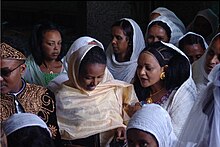
A decade ago, only 25 percent of university graduates were women. Today that number ranges between 40 and 50 percent, depending on the institution and the field of study. In Eritrea it is believed that early marriage secures more children. On the other hand, an unmarried female can be considered as a burden to the collective family and societal structure. Families in rural areas expect there daughters to get married early sometimes before the age of 18 years old. [10] The average distance for elementary, middle and secondary school levels is contributing to the low education enrollment for women. At a national level, on average students are required to travel 5.3 km at elementary school level, 21.76 km at middle school level and 63.53 km at secondary school level. Schools are not close to students’ homes or villages and the average distance increases with the increase in the level of schooling (elementary school, middle school, secondary school). The reason for this is due to a lack of schools particularly middle and secondary schools being built in more remote areas of Eritrea.
An Eritrean girl must travel a long distance, or either, leave home to live in a rented house or with relatives outside the family village. This is hard for girls who are generally not allowed to travel long distances or rent houses in the urban areas to continue their education for safety reasons. Distance to the schools is a major barrier to girls education in Eritrea. Women represent about 50% of all teachers in elementary-level schools, and about 10% of all teachers at middle and secondary-level schools. [11]
Almost 40 percent of women in Eritrea are married by their 21st birthday. Limited access to education is associated with the high prevalence of child marriage in Eritrea. 64% of women aged 20–24 with no education and 53% with primary education were married by 21 years old, compared to just 12% of women with secondary education or higher. [12] UNICEF estimates that 4 in 10 women are married in childhood. [13] The Eritrean Civil Code (articles 329 and 581) sets the minimum age of marriage at 18 years for both girls and boys although this is the case because of social norms women still get married at younger ages. This makes it difficult for women to pursue higher education because they are expected to work in subsistence agriculture and prepare food for their family at a young age. (Nolan White, All)

Female genital mutilation (FGM) is the ritual cutting or removal of some or all of the vulva. The practice is found in some countries of Africa, Asia and the Middle East, and within their respective diasporas. As of 2023, UNICEF estimates that "at least 200 million girls... in 31 countries"—including Indonesia, Iraq, Yemen, and 27 African countries including Egypt—had been subjected to one or more types of female genital mutilation.

Isaias Afwerki is an Eritrean politician and partisan who has been the president of Eritrea since shortly after he led the Eritrean People's Liberation Front (EPLF) to victory in 24 May 1991, ending the 30-year-old war for independence from Ethiopia. In addition to being president, Isaias has been the chairman of Eritrea's sole legal political party, the People's Front for Democracy and Justice (PFDJ). As Eritrea has never had a functioning constitution, no elections, no legislature and no published budget, Isaias has been the sole power in the country, controlling its judiciary and military. Hence, scholars and historians have long considered him to be a dictator, described his regime as totalitarian, by way of forced conscription; the United Nations and Amnesty International cited him for human rights violations. In 2022, Reporters Without Borders ranked Eritrea, under the government of Isaias, last out of 180 countries in its Press Freedom Index. In 2023 Eritrea ranked 174th out of 180 countries on the Press Freedom Index.

The People's Front for Democracy and Justice is the founding, ruling, and sole legal political party of the State of Eritrea. The successor to the Marxist–Leninist Eritrean People's Liberation Front (EPLF), the PFDJ regards itself as a left-wing nationalist party, though it holds itself open to nationalists of any political affiliation. The leader of the party and current President of Eritrea is Isaias Afwerki. The PFDJ has been described as totalitarian, and under its rule Eritrea reached the status of the least electorally democratic country in Africa according to V-Dem Democracy indices in 2023.

The Eritrean People's Liberation Front (EPLF), colloquially known as Shabia, was an armed Marxist–Leninist organization that fought for the independence of Eritrea from Ethiopia. It emerged in 1973 as a far-left to left-wing nationalist group that split from the Eritrean Liberation Front (ELF). After achieving Eritrean independence in 1991, it transformed into the People's Front for Democracy and Justice (PFDJ), which serves as Eritrea's sole legal political party.
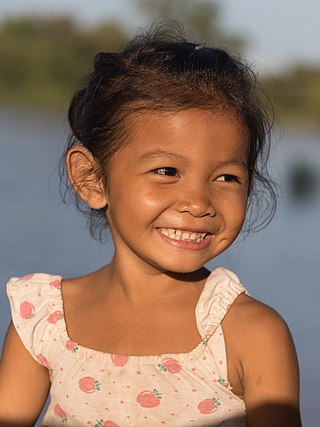
A girl is a young female human, usually a child or an adolescent. When a girl becomes an adult, she is generally referred to as a woman. However, the term girl is also used for other meanings, including young woman, and is sometimes used as a synonym for daughter or girlfriend regardless of age. In certain contexts, the usage of the term girl for an adult woman may be considered derogatory. Girl may also be a term of endearment used by an adult, usually a woman, to designate adult female friends. Girl also appears in compounds like showgirl, cowgirl, and schoolgirl.

The People's Democratic Republic of Ethiopia was a socialist state that existed in Ethiopia and present-day Eritrea from 1987 to 1991.

The Eritrean Liberation Front, colloquially known as Jebha, was the main independence movement in Eritrea which sought Eritrea's independence from Ethiopia during the 1960s and the early 1970s. It was established in 1960 after Ethiopian Emperor Haile Selassie violated a 1952 UN resolution that guaranteed Eritrea the right to an autonomous government. Idris Muhammad Adam and other Eritrean intellectuals founded the ELF as a primary Pan Arab movement in Cairo, but the first attack was led by Hamid Idris Awate in 1961. Over the course of the 1960s, the ELF was able to obtain support from Arab countries such as Egypt and Sudan. However, tensions between Muslims and Christians in the ELF along with the failure of the ELF to ward off Ethiopia's 1967–1968 counter offensive internally fractured the ELF, causing it to split. By the mid 1970s, the ELF and the Eritrean People's Liberation Front (EPLF), an ideologically Maoist liberation movement, were the key liberation movements in Eritrea. The EPLF ultimately overtook the ELF as the primary Eritrean independence movement by 1977, and the ELF was subsequently defeated in 1981.

The Eritrean War of Independence was a war for independence which Eritrean independence fighters waged against successive Ethiopian governments from 1 September 1961 to 24 May 1991.

Education in Eritrea is officially compulsory between 7 and 16 years of age. Important goals of Eritrea's educational policy are to provide basic education in each of Eritrea's mother tongues as well as to produce a society that is equipped with the necessary skills to function with a culture of self-reliance in the modern economy. The education infrastructure is currently inadequate to meet these needs.
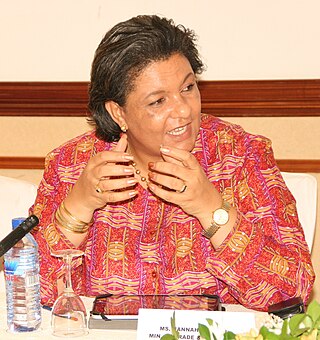
The status of women in Ghana and their roles in Ghanaian society has changed over the past few decades. There has been a slow increase in the political participation of Ghanaian women throughout history. Women are given equal rights under the Constitution of Ghana, yet disparities in education, employment, and health for women remain prevalent. Additionally, women have much less access to resources than men in Ghana do. Ghanaian women in rural and urban areas face slightly different challenges. Throughout Ghana, female-headed households are increasing.
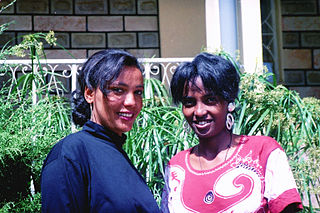
There have been several studies concerning women in Ethiopia. Historically, elite and powerful women in Ethiopia have been visible as administrators and warriors. This never translated into any benefit to improve the rights of women, but it had meant that women could inherit and own property and act as advisors on important communal and tribal matters. As late as the first part of the 20th century, Queen Menen, consort of Emperor Iyasu IV, had a decisive role in running the Ethiopian Empire. Workit and Mestayit regents to their minor sons have been held responsible for their provinces. They owed their rights to landed property because of a special type of land tenure that expected tenants to serve as militia to overlords, irrespective of gender. In 1896, Empress Tayetu Betul, wife of Emperor Menelik II, actively advised the government and participated in defending the country from Italian invasion. Prominent and other landowning women fought against the second invasion in 1935–41. With the assistance of European advisors, women in the ensuing period were kept out of the army and politics, even as advisors. Instead, they were restricted to family and household work of raising children and cooking. With a steady increase in female representation in education, they have started to undertake nursing, teaching, and other similarly supportive roles. Over the 2018–2019 period, their gradual participation in state politics has been increasing at a steady pace.
Gender inequality in India refers to health, education, economic and political inequalities between men and women in India. Various international gender inequality indices rank India differently on each of these factors, as well as on a composite basis, and these indices are controversial.
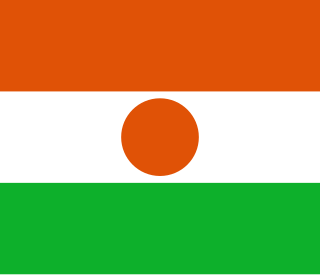
Education in Niger, as in other nations in the Sahelian region of Africa, faces challenges due to poverty and poor access to schools. Although education is compulsory between the ages of seven and fifteen, with primary and secondary school leading into optional higher education, Niger has one of the lowest literacy rates in the world. With assistance from external organizations, Niger has been pursuing educational improvement, reforming how schools utilize languages of instruction, and exploring how the system can close gender gaps in retention and learning.

The status and social roles of women in Mali have been formed by the complex interplay of a variety of traditions in ethnic communities, the rise and fall of the great Sahelien states, French colonial rule, independence, urbanisation, and postcolonial conflict and progress. Forming just less than half Mali's population, Malian women have sometimes been the center of matrilineal societies, but have always been crucial to the economic and social structure of this largely rural, agricultural society.
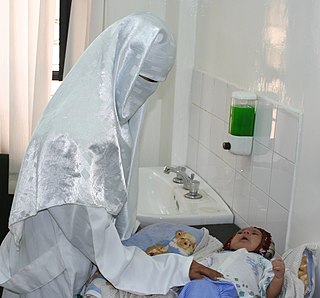
Women in Yemen have historically been placed at a disadvantage due to their gender, with a highly patriarchal society. Although the government of Yemen has made efforts that will improve the rights of women in Yemen, many cultural and religious norms, along with poor enforcement of this legislation from the Yemeni government, have prevented Yemeni women from having equal rights to men.

Females in Nigeria have a basic human right to be educated, and this right has been recognized since the year 1948 adoption of the Universal Declaration on Human Rights (UDHR) According to a report in 2014, female education has an important impact on the development of a stable, prosperous and healthy nation state resulting in active, productive and empowered citizens. Educating girls develop growth rates, encourages independence of the girl child and reduces social disparities. In 2009, the Nigerian Population Council (NPC) observed that women with higher educational qualifications are more likely to be in formal wage employment than those at the level of primary school education.
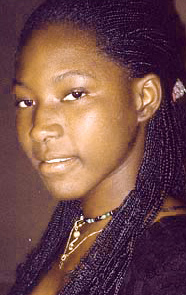
Women in Chad, a landlocked country in Central Africa, are the mainstay of its predominantly rural-based economy and they outnumber the men. Chad is a country with diverse and rich cultural practices, such as male beauty pageants and long-kept-secret hair products. Despite their numbers in the general population, there are very few women in governmental positions and gender equality is far from being a reality in Chad. Chad is rated by the World Bank as the third least gender equal country in Africa. Additionally, there are few women who attain higher education, and many who receive a college degree do so outside of the country.
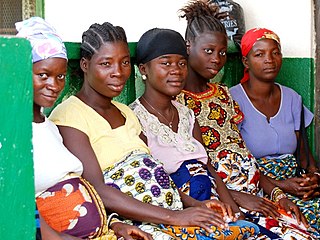
The extent of gender inequalities varies throughout Liberia in regard to status, region, rural/urban areas, and traditional cultures. In general, women in Liberia have less access to education, health care, property, and justice when compared to men. Liberia suffered two devastating civil wars from 1989–1996 and 1999–2003. The wars left Liberia nearly destroyed with minimal infrastructure and thousands dead. Liberia has a Human Development Report ranking of 174 out of 187 and a Gender Inequality Index rank of 154 out of 159.
Genet Sium is an Eritrean writer, activist, and nurse. She was an active member of the Eritrean People's Liberation Front (EPLF) during the war for Eritrean independence from Ethiopia. Her autobiographical novel Shigom recounts her experiences as a freedom fighter. She has subsequently written several works of fiction as well as texts on sexual and reproductive health.
Solomon Tsehaye Beraki is an Eritrean poet, academic and politician. He wrote the national anthem of Eritrea, "Eritrea, Eritrea, Eritrea". As of 2019, he was working in the Eritrean Ministry of Education.